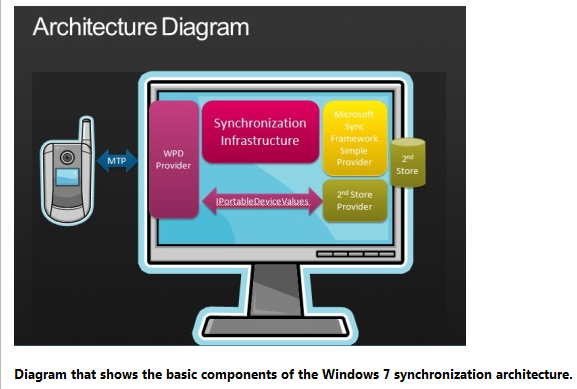It takes a lot of syncing to build a Microsoft personal cloud

When Microsoft officials talk about syncing devices and services, they can be referring to any number of different Microsoft sync technologies. There's ActiveSync, Windows Live Sync, Sync Framework, Windows Sync, the synchronization provided via the Zune PC software client... and lots more.
Several of these sync technologies are essential to realizing what Microsoft marketing execs (and Forrester Research analysts) have started referring to as the "personal cloud." Microsoft execs talked up the potential of the personal cloud earlier this summer at both the Worldwide Partner Conference and the Microsoft Financial Analyst Meeting (FAM).
Corporate Vice President of Windows Consumer Marketing Brad Brooks told Wall Street analysts and press they'd be hearing and seeing more from Microsoft about the personal cloud later this year. He said that Microsoft is one of four tech companies (with the others being Apple, Google and Facebook) who are set to deliver "multiple components of the emerging Personal Cloud user experience."
"Speaking of cloud and Windows, we have a unique point of view on the cloud for consumers, and we call it the PC. Only in this case we call it the personal cloud," Brooks told FAM attendees in late July. "And the personal cloud, well, it's going to connect all the things that are important to you and make them available and ready for you to use wherever you're at, whenever you need it."
Windows Live Essentials -- a suite consisting of a number of Microsoft's Windows Live services, and which just this week got a "beta refresh" -- is one element of Microsoft's personal cloud experience. Brooks also included Windows 7, Bing, Xbox Live, Zune, Windows Phone 7 and "client virtualization technologies that so far are aimed mostly at IT managers"
Microsoft's personal cloud experience works like this: Your Windows (preferably Windows 7) PC is the hub. From there, you can connect and sync various devices, like your phone, your gaming console, etc. In some cases, you'll be able to sync directly from the devices to the cloud. But the main goal, from Microsoft's standpoint, is to keep the PC at the center of a user's syncing existence.
This fall/winter -- when Microsoft rolls out the final version of its Windows Live Essentials 2011 bundle and its phone partners start selling Windows Phone 7 devices -- Microsoft execs will be touting how these products are enhanced by the personal cloud. That sounds a lot fancier than saying Windows 7/Vista and Windows Phone 7 users will be able to install and run the new Windows Live Messenger, Mail, Family Safety parental controls and Live Sync (which is what they really mean).
Speaking of Live Sync, Microsoft officials have conceded (and beta testers realize) that the coming version allows users to sync their Windows PCs and Macs. But it doesn't support phones -- not even Windows Phones. And the Zune PC client (codenamed "Dorado"), which will enable the personal cloud synchronization between Windows PCs and Windows Phone 7 devices is dedicated to syncing digital media content, not things like contacts or e-mail, as Windows SuperSite's Paul Thurrott (who is writing a Windows Phone 7 book) noted in a recent blog post.
Microsoft execs tend to gloss over this reality in their demos. What's enabling them to seamlessly sync their photos on their Windows Phone 7s with their Windows 7 PCs? It's not the coming version of Windows Live Sync. And I don't think it's the Zune sync, either.
Maybe it's Windows Sync? That seemed to be what Brooks was telling FAM attendees last month, according to the transcript of his remarks (unless Brooks was talking about Windows Live Sync, which I'm doubting, since the coming 2011 Essentials version doesn't support phones). Brooks said:
“Well, now with the new Windows Sync feature, I can choose one folder or choose all my folders on a PC, and choose to share them and they automatically sync up in the background whenever I'm connected to the Internet. So, that means all my files and all my content across all these devices always keep in sync.”
Windows Sync is a feature built into Windows 7. According to Microsoft, "(u)sing Windows Sync, developers can write synchronization providers that keep data stores such as contacts, calendars, tasks, and notes on a computer or on a network synchronized with corresponding data stores in personal information managers (PIMs) and smart phones that support synchronization."
After clicking around for a while on some of the Windows Sync links, I realized Windows Sync builds on Microsoft's Sync Framework. What's the Sync Framework? Microsoft's description:
"Sync Framework a comprehensive synchronization platform enabling collaboration and offline for applications, services and devices. Developers can build synchronization ecosystems that integrate any application, any data from any store using any protocol over any network. Sync Framework features technologies and tools that enable roaming, sharing, and taking data offline."
(By the way, Microsoft just rolled out this week Version 2.1 of the Sync Framework, which adds SQL Azure synchronization as an option.)
I tried to get more clarity from company execs about Microsoft's consumer sync strategy but had little luck, as a result of many Softies being on vacation (and the fact that Microsoft is still, no doubt, ironing out the details of its fall rollouts.)
Does any of this under-the-covers stuff really matter? I realize Microsoft (hopefully) will isolate consumers from sync programming interfaces and sync providers, but I'm wondering how seamless -- and complete -- Microsoft's personal cloud actually will be. "Version 1" of this personal cloud experience seems like it will be neither. Maybe that's OK for a "V1." I guess we'll see soon....
